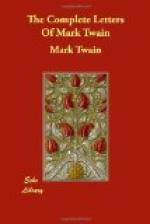XXIX
Letters, 1889. The machine.
Death of Mr. Crane.
Conclusion of the Yankee
In January, 1889, Clemens believed, after his long seven years of waiting, fruition had come in the matter of the type machine. Paige, the inventor, seemed at last to have given it its finishing touches. The mechanical marvel that had cost so much time, mental stress, and a fortune in money, stood complete, responsive to the human will and touch —the latest, and one of the greatest, wonders of the world. To George Standring, a London printer and publisher, Clemens wrote: “The machine is finished!” and added, “This is by far the most marvelous invention ever contrived by man. And it is not a thing of rags and patches; it is made of massive steel, and will last a century.”
In his fever of enthusiasm on that day when he had actually seen it in operation, he wrote a number of exuberant letters. They were more or less duplicates, but as the one to his brother is of fuller detail and more intimate than the others, it has been selected for preservation here.
To Orion Clemens, in Keokuk:
Hartford, Jan. 5, ’89. Dear Orion,—At 12.20 this afternoon a line of movable types was spaced and justified by machinery, for the first time in the history of the world! And I was there to see. It was done automatically—instantly —perfectly. This is indeed the first line of movable types that ever was perfectly spaced and perfectly justified on this earth.
This was the last function that remained to be tested—and so by long odds the most amazing and extraordinary invention ever born of the brain of man stands completed and perfect. Livy is down stairs celebrating.
But it’s a cunning devil, is that machine!—and knows more than any man that ever lived. You shall see. We made the test in this way. We set up a lot of random letters in a stick—three-fourths of a line; then filled out the line with quads representing 14 spaces, each space to be 35/1000 of an inch thick. Then we threw aside the quads and put the letters into the machine and formed them into 15 two-letter words, leaving the words separated by two-inch vacancies. Then we started up the machine slowly, by hand, and fastened our eyes on the space-selecting pins. The first pin-block projected its third pin as the first word came traveling along the race-way; second block did the same; but the third block projected its second pin!
“Oh, hell! stop the machine—something wrong—it’s going to set a 30/1000 space!”
General consternation. “A foreign substance has got into the spacing plates.” This from the head mathematician.
“Yes, that is the trouble,” assented the foreman.




